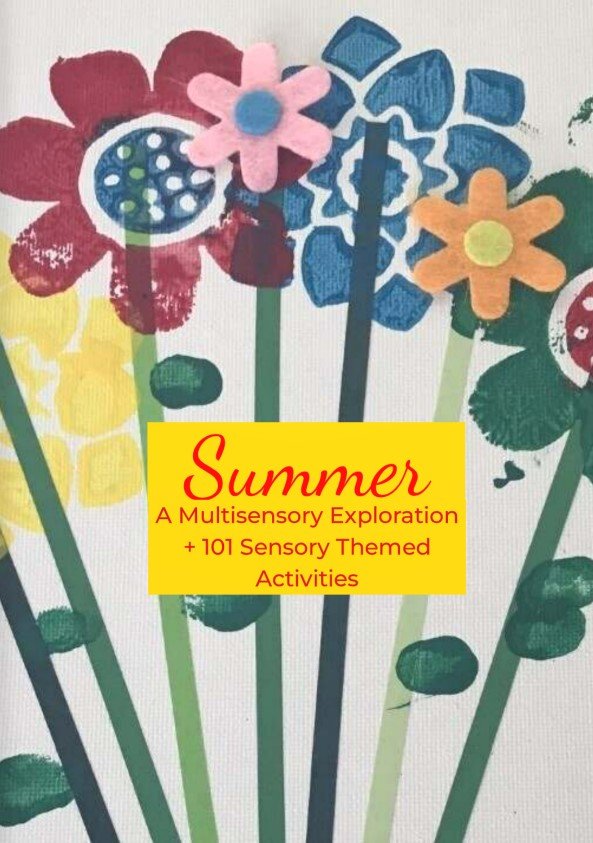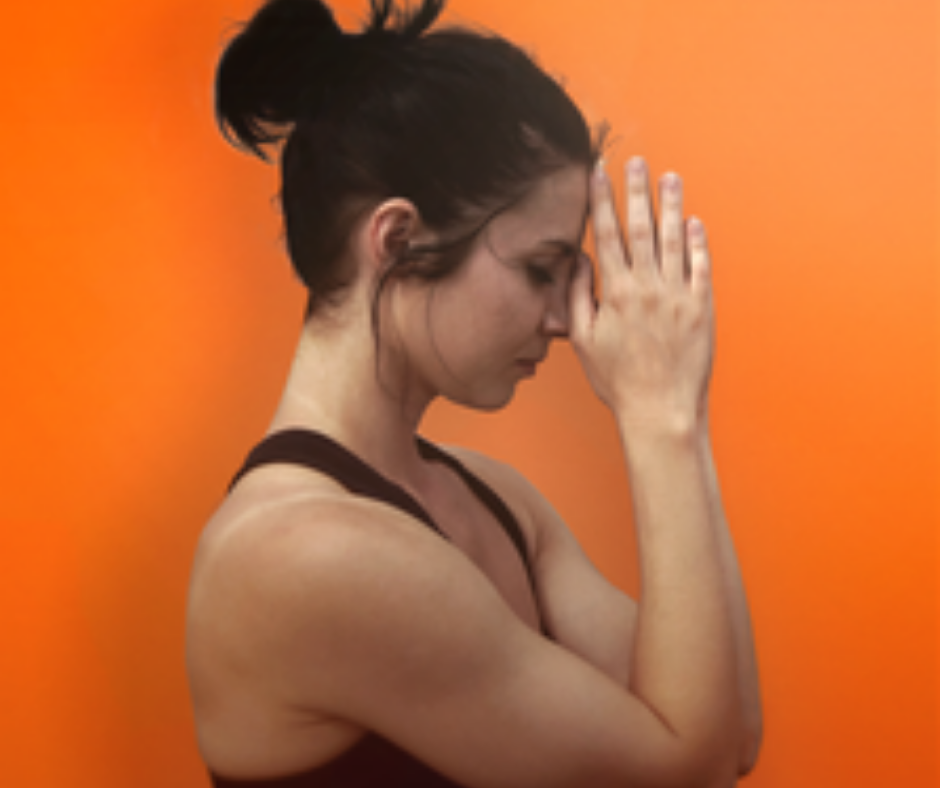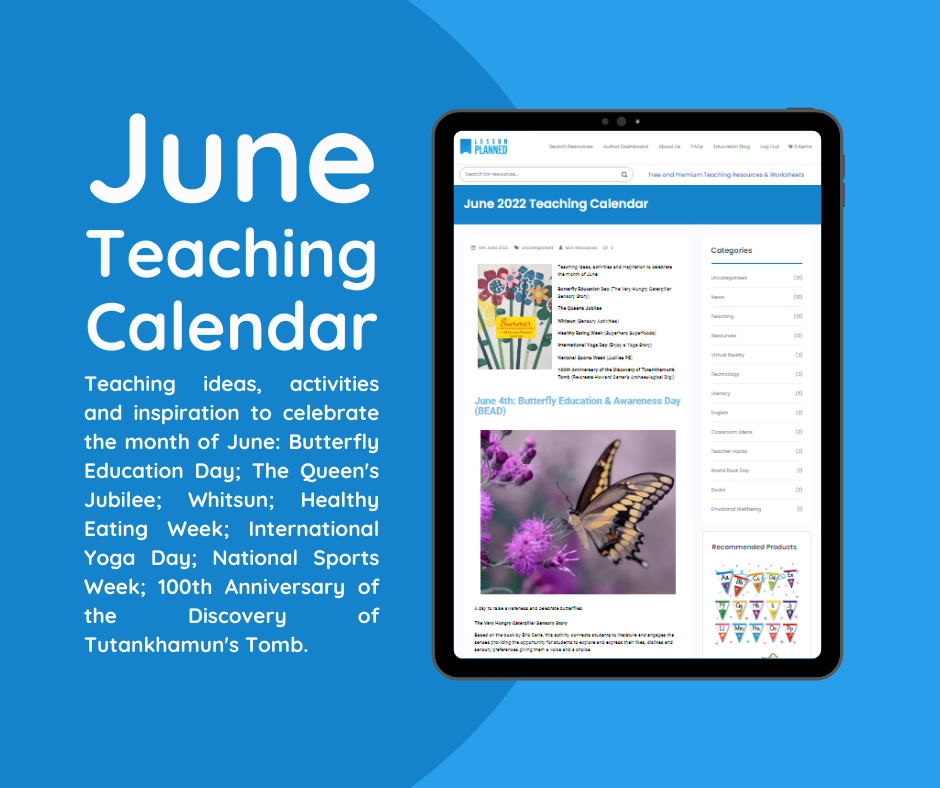- 6th June 2022
- Uncategorised
- MJ's Resources
- 0

Butterfly Education Day (The Very Hungry Caterpillar Sensory Story)
The Queen’s Jubilee
Whitsun (Sensory Activities)
Healthy Eating Week (Superhero Superfoods)
International Yoga Day (Enjoy a Yoga Story)
National Sports Week (Jubilee PE)
100th Anniversary of the Discovery of Tutankhamun’s Tomb (Re-create Howard Carter’s Archaeological Dig!)
June 4th: Butterfly Education & Awareness Day (BEAD)

The Very Hungry Caterpillar Sensory Story
Based on the book by Eric Carle, this activity connects students to literature and engages the senses providing the opportunity for students to explore and express their likes, dislikes and sensory preferences giving them a voice and a choice.
You will need:
- Torch
- Leaf
- Egg (Pop a drop of glue on the leaf then leave to dry)
- Red and Green Pipe Cleaners
- Apple
- Pear
- Plum
- Strawberries
- Oranges
- ‘The Very Hungry Caterpillar’ book by Eric Carle
Read ‘The Very Hungry Caterpillar’ story by Eric Carle presenting the props/sensory stimuli as they appear in the story.
- The Leaf: Dim the lights then shine the torch onto the leaf. Can the students find the egg? Explore cause and effect, can the students use turn the torch ON/OFF?
- The Caterpillar: Promote fine motor skills. Can the students twist their red and green pipe cleaners to make a caterpillar?
- The Fruit: Engage the senses and explore likes, dislikes and sensory preferences. Offer the apples, pears, plums, strawberries and oranges for the students to touch, smell and taste. Can the students choose between two preferred items? Can the students make a rejection if they do not like any of the items?
- The Other Foods: Print out and laminate a matching board with the chocolate cake, ice cream, swiss cheese, salami, lollipop, cherry pie, sausage, melon and a cupcake. Print out a set of matching pictures. Can the students match the correct picture to the one on the matching board?
Extend Learning
Cut the pictures out.
Can the students place the pictures in the correct order that the items appear in the story?
5. The Lettuce Leaf: Offer lettuce leaves for the students to touch, smell and taste. Discuss healthy eating. Can the students group the food items into healthy foods and foods you would eat as a treat? (Link to ‘Healthy Eating Week 13-17 June)
6. The Cocoon: Can the students climb into a sleeping bag or stretch in a body sock like the caterpillar?
7. The Butterfly: Open your parachute and move it up and down slowly like the wings of a butterfly.
Parachute Game: Place plastic fruits on the parachute.
Can the students keep the fruit on the parachute as it is lifted up and down?
If the fruits drop, can the students catch and name them.
Extend Learning:
Can the students retell the story using the props?
Extension Activity:
Can the students make a fruit kebab containing the correct quantities of fruit as they appear in the story? (one apple, two (pieces of) pear, three (pieces of) plums, four strawberries, five (pieces of) oranges?
Health & Safety Advice
Be Allergy Aware
Beware of Potential Choking Hazards (remove pips/stones/seeds)
Non-Food Alternative Activity
Read the story then explore dried fruit peel, scented body lotions/creams and/or essential oils.
Can the student show a preference for a scent or make a rejection if they do not like a scent?
Advice: When working with scents, start at a distance and work your way towards the student taking their lead as to some individuals, smells may be overpowering.
Plant a butterfly garden
You will need:
- Bowl
- Wildflower Seeds
- Tissue Paper
- Water
- Spoon
Method
- Tear or cut the tissue paper into tiny pieces and place into the bowl.
- Add the wildflower seeds.
- Mix using a spoon or your hands.
- Add a little water to bind.
- Roll into balls.
- Leave to dry on a sunny windowsill.
- Throw or plant into the garden/outdoor area.
- Watch as your garden/outdoor area transforms into a carpet of colour!
- At the end of summer, harvest the dried seeds and store in a paper bag ready to plant next year!
Explore the life cycle of a butterfly
If you have a class budget, purchase a butterfly growing kit. Raise and feed your own butterflies watching them transform from caterpillars to adult butterflies before releasing into the wild.
June 4th 2022: The Queen's Jubilee

Here are some jubilee themed sports activities that will also tie in your Sports Day and with National Sports Week June 20th – 26th
Jubilee Themed Obstacle Course Ideas
1. Afternoon Tea Tray Race: Balance a plastic/stainless steel teapot, plastic cups & saucers and teaspoons on a tray. Can the competitors carry the tray along the running lane without dropping the items?
2. Cup of Tea Relay Race: Seep herbal teabags in cold water and place in a bucket. The competitor must fill their teacup from the bucket, then carry their teacup to the end of the racing lane without spilling too much tea. When they reach the end of the racing lane they must tip the contents into a container. A second team member must the run back to the bucket with the empty teacup, refill it then carry it back to the empty it in the container. Repeat until all of the team members have raced. This is a race of skill not speed and the winners are the team whose container contains the most tea!
Roll the Carriage Wheel: Tie red, white and blue ribbons onto a hula hoop. Can the competitors roll their carriage wheel along the racing track?
Red, White and Blue Race: Scatter red, white and blue beanbags or balls at intervals along the racing lane. The competitors must collect and carry the beanbags/balls to the end of the lane without dropping them. The winner is the person with the most beanbags/balls.
Flag Relay Race: Replace a baton for a Union Jack.
Crown Race: Can the competitors race balancing a crown on their heads? (No holding on with the hands!)
Balloon Baskets: Inflate red, white and blue balloons. How many balloons can the competitor hit into a laundry basket using their hands, feet, head or a bat?

The Queen’s Jubilee – A Multisensory Adventure
£3.98
Join our character as s/he visits the Queen at Buckingham Palace with this fully resourced, step-by-step multisensory story.
Includes 70 sensory, jubilee themed extension activities linking to areas of the curriculum.
Table of Contents The Benefits of Multisensory Storytelling; How to tell a Multisensory Story Story Props/Resources; The Queen’s Jubilee Fully Resourced Step-By-Step Multisensory Story; The Queen’s Sensory Handbag; The Crown Jewels The Queen’s Perfume; The Queen’s Teapot; The Jubilee Beacons; The Union Jack; The River of Hope; The Jubilee Time Capsule; Jubilee Expressive Arts & Drama; Jubilee D&T Cooking & Nutrition; Independent Life Skills; Jubilee PE; Jubilee PSHE Games; Jubilee D&T; Jubilee Arts & Crafts; Jubilee Music; Jubilee RE; The Queen’s Post Box; The Queen’s Green Canopy.
June 5th: Whitsun

Whitsun is celebrated on the 50th day after Easter. It is a Christian celebration marking the coming of the Holy Spirit.
There are many traditional activities associated with Whitsun including fetes, fairs, pageants, parades, walks and Morris dancing.
Explore Morris Dancing
Watch footage of Morris Dancing
Can the students copy the movements to form a Morris Dance?
You will need
- Handkerchiefs
- Ankle & Wrist Bells
- Jingle Bell Shakers
- Ribbons
- Garlands (weave ribbons through a hula hoop)
- Straw Hats
Alternative Activity
Morris Dancer Sensory Box
- Layer a box with shredded paper.
- Place items related to Morris Dancing into the box: Handkerchiefs, Ankle & Wrist Bells, Jingle Bell Shakers, Ribbons and Garlands.
- Encourage the student to place their hand inside the box and choose and item to explore.
- Model the items function. Can the student copy your actions? Model the language.
- To add a little interest, dim the lights and use a torch to explore the items. A wind-up Dynamo torch will promote fine motor skills, a head torch provides a ‘hands free’ option.
13 - 17th June: Healthy Eating Week

Explore Superhero Superfoods*
Add excitement to the topic of healthy eating by exploring superhero superfoods!
Present a wide range of different tastes and textures for the individual to explore at their own pace.
Initial explorations could be through touch and smell, the next step to present a tiny touch to the lips progressing onto a morsel or a drop in the mouth, an egg spoon full then building up to a full bite.
Be Allergy Aware!
Popeye knew that spinach was packed with vitamins to make him strong and healthy!
Explore Healthy Green Foods: Apples, Avocados, Beans, Broccoli, Courgettes, Cucumber, Green Peppers, Kiwi, Lettuce, Watercress.
Ironman needs foods containing iron in his diet: Broccoli, Dark Chocolate, Dried Apricots, Legumes (Beans, Lentils, Chickpeas, Peas, and Soybeans), Pumpkin Seeds, Spinach, Tofu.
Superman’s Superfoods
Apples, Avocados, Bananas, Blackberries, Beans, Blueberries, Carrots, Cauliflower, Cherries, Courgettes, Figs, Fish Oils, Flaxseed, Garlic, Grapefruit, Herbs, Kiwi, Melon, Onion, Pepper, Plums, Pulses, Pumpkin, Rye, Spices, Strawberry, Watercress.
D & T Food Activity: Make Lettuce Wraps
You will need:
- Washed Whole Lettuce Leaves
- Herbs: Basil, Chives, Coriander, Dill, Mint, Mustard Seeds, Paprika, Parsley
- Salad Items: Beetroot, Cherry Tomatoes, Cress, Cucumber, Spring Onions, Watercress
- Cheese Slice, Croutons
- Coleslaw, Pickled Onions, Red Cabbage
- Dips: Aioli, Guacamole, Hummus, Onion Dip, Raita, Salsa, Sour Cream, Tzatziki,
- Condiments: Balsamic Vinegar, Mayonnaise, Piccalilli, Salad Cream, Vinaigrette.
Method:
- Lay the lettuce leaf flat.
- Add the ingredients
- Top with a dip or condiment
- Roll
- Eat!
June 21st: International Yoga Day

Yoga is relaxing and good for the mind and body.
The following are suggested poses and do not have to be exact, focus on relaxation and exploring and enjoying movement.
Yoga is best practiced with bare feet on a mat.
Always stretch very gently and never force movement.
It is fun to adapt a story into a yoga session.
Morning Routine Yoga Story
‘Its 7am and you are fast asleep’
Students lie on their back, arms by their sides like soldiers
(Corpse Pose)
‘At 7.30am the alarm rings, you roll over to switch it off’
Students roll onto their right side and stretch their left arm to turn an imaginary alarm clock off – option to use sound effects.
‘You very slowly sit up and cross your legs’
(Lotus Pose)
‘You are thankful for another beautiful day’
Students place the palms together in a prayer position.
(Continuation of Lotus Pose)
‘You stand up and stretch’
Students stand up straight with their feet at hip distance apart pressed to the floor and their arms at their sides.
(Mountain Pose)
‘Time for breakfast! Reach for the cereal box on the high shelf.’
From the Mountain the students bring their arms out to the sides and raise them above their heads bringing the palms together.
(Upward Hands Pose)
‘The school bus/taxi has arrived, find a seat and sit down’
Students bring their arms to their sides, bend the knees and squat as if sitting on a chair
(Chair Pose)
‘You arrive at school and your first lesson is learning some fascinating facts about how animals move’
(Take a short break and relax your body)
‘Owls can turn their heads 270 degrees!’ Students sit upright on their heels, and twist the upper body to the left, then to the right.
(Owl Pose)
‘The wings of a butterfly move in a figure of eight motion’
Students sit on their buttocks and with a tall spine, bend their legs, placing the soles of their feet together, then slowly move their legs like the wings of a butterfly.
(Butterfly Pose)
‘Snakes defy gravity and can move up walls’
Students lie on their front, place the palms flat next to their shoulders then lift their head and shoulders off ground.
(Cobra Pose) ‘The fastest fish to cover short distances is the sailfish (109km per hour) Students lie on their front with their knees bent, lift the chest and reach their arms back towards their toes. Can they stretch to hold their feet? (Fish Pose)
‘Dogs have 18 muscles in their ear that can move in lots of directions to help them hear’ From a standing position, the students bend down and place their palms flat on the ground, stepping the feet back to create an upside-down V shape with their buttocks high in the air. Straighten the legs, relax the head and neck and look down between their legs.
(Downward Dog)
‘Cats can turn themselves the right side up in mid-air if they should fall upside-down’
Students position themselves on all-fours, rounding their backs and tucking their chins into the chest.
(Cat Pose)
‘Mice use their whiskers to sense temperature and rough/smooth edges’
Students sit on their heels, slowly bring their forehead down to rest in front of their knees the rest their arms down alongside your body.
(Mouse Pose)
END OF SESSION
June 21st: Summer Solstice
Congratulations to the very talented Megan Dunwell (age 12) from Greater Manchester who won the competition to design the cover for the upcoming new release ‘Summer – A Multisensory Exploration’ £3.98
Megan made this picture at home with her lovely Mum.
The design was printed onto canvas.
The stems are ribbons.
Megan chose which flower and colour she wanted to use each time from choice of 2 different options.
The leaves are Megan’s fingerprints which added a personal touch.
‘Summer – A Multisensory Exploration’ is a bumper resource and includes 101 summer themed sensory extension.

The resource also includes a feature called ‘Summer Sensory Art’, three fantastic summer art projects made by the fabulous students at Hebden Green School in Winsford, Cheshire. The feature includes all the information you need to re-create the artwork!
Table of Contents
About the Artist; The Benefits of Multisensory Storytelling; How to Tell a Multisensory Story; Story Props Checklist; Summer Full Poem/Story; Summer Senses; Summer Nature; Nature’s Art Room; Independent Skills – Task Boxes; Life Skills; Summer Safety; Bubbles & Sand Dough; Summer Sounds; Summer Role Play; D & T Summer Food; Understanding the World; D & T; The Summer Garden; Outdoor Learning; Pebble Painting; Summer Maths; Summer P.E; Culture – Traditional Clothing; Summer Festivals Around the World; Summer Science; Summer Plants & Life Cycles; Butterflies; Spotlight on…Hebden Green School; Sensory Art ‘Sparrow’s sensory Sun’; Sensory Art – ‘Barn Owls Summer Exploration’; Sensory Art- ‘Starlings – We’re all Going on a Summer Holiday’
If you would like your school to feature in my next teaching resource, get in touch!
You can message me via the website, through social media or send an email to rhymingmultisensorystories@outlook.com
Sensory History - 100 Years Ago The Discovery of Tutankhamun's Tomb
This year marks to the 100th anniversary of the discovery of Tutankhamun’s tomb by Howard Carter and his team.
Re-Create Howard Carter’s Archaeological Dig
This sensory play engages the senses as the students manipulate the objects, promotes fine motor skills and connects students to history.
You will need:
A Base Layer:
Sand (Bury items into the soil/sandpit in the outdoor learning area. Alternatively use a box, bucket or similar container)
Soil/Stones/Pebbles (for a ‘less mess’ option use pulses, barley/lentils/dried beans)

Items to Promote Fine Motor Skills:
Paintbrushes (assorted sizes), rocks, sieve, spoons, toothbrush, toothpicks, watering can/water spray bottle.
Containers for Storing Items:
Boxes, Baskets, Tupperware, Shoe Box, Egg Carton.
‘Egyptian Treasure:
Coins, Jewellery, Rings (metal washers are a cheap alternative), Brooches, Gemstones (Glass Pebbles), Clay Jug/Cup.
Paintings were found in Tutankhamun’s tomb, print and laminate hieroglyphics and bury in the sand.
Replicate Items Discovered in Tutankhamun’s Tomb: Burial Mask (Print and laminate a picture of Tutankhamun’s mask), Model Boat, Board Games (bury a few counters), Clay Jars, a Fan, Sandals.
Herbs: Bury herbs that Egyptians used: Sage, Cinnamon Sticks, Cumin Seeds, Fennel, Coriander, Garlic Bulbs, Juniper Berries, Thyme.
Items to Promote Scientific Investigation: Camera, Magnifying Glass, Notebook, Pen/Pencil, Torch.
Encourage students to use the tools to unearth treasure and the record their findings.
Extend Learning:
Can the sensory explorer describe the item or name the material the item is composed of?
Can the sensory explorer tell you what an item might have been used for?
Add a couple of ‘red herring’ items (e.g. an item made of plastic, a toy phone, a crisp packet)
Get in Touch!
email: rhymingmultisensorystories@outlook.com
Website: www.rhymingmultisensorystories.com
Facebook Page: Rhyming Multisensory Stories
Facebook: Victoria Navin RMSS
LinkedIn: Victoria Navin Rhyming Multisensory Stories
Twitter: @RhymingStories
Instagram: rhyming_multisensory_stories
MySpace: Rhyming Multisensory Stories
Tumblr: rhymingmultisensorystories
Reddit: sensorystories
Pinterest: Rhyming Multisensory Stories
YouTube: Rhyming Multisensory Stories

